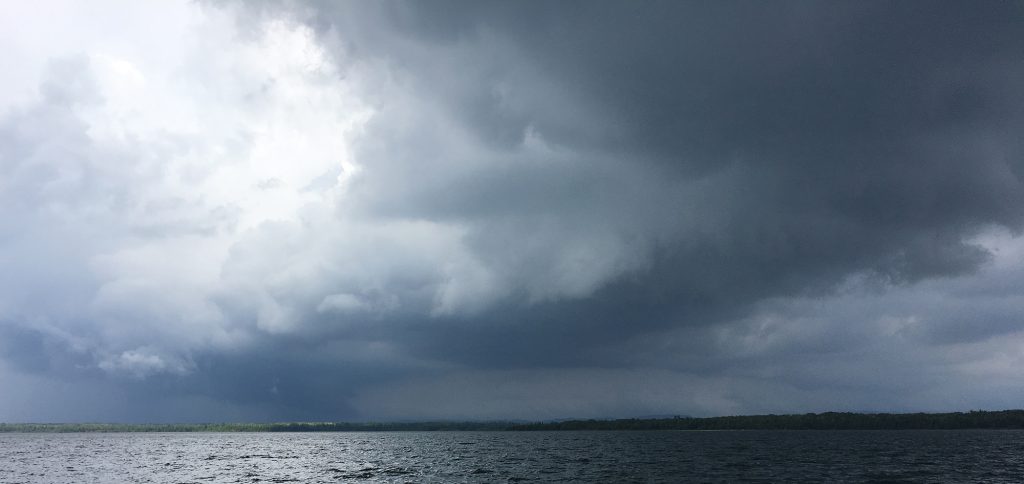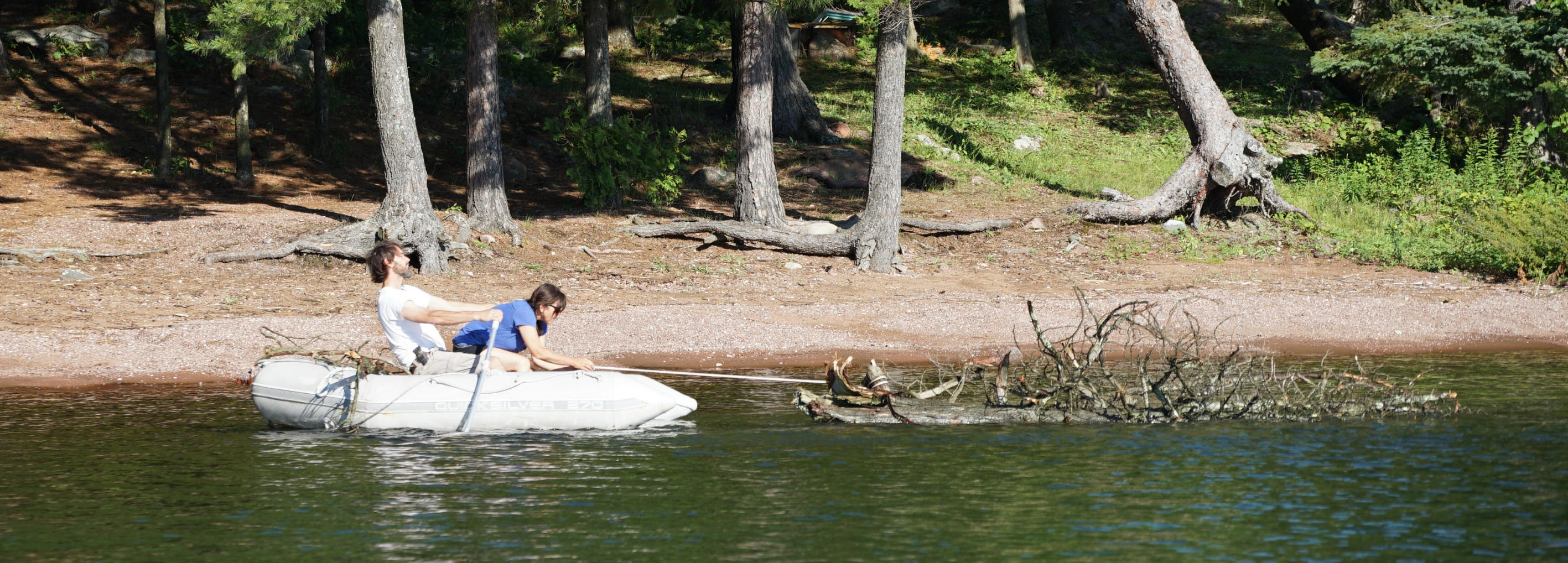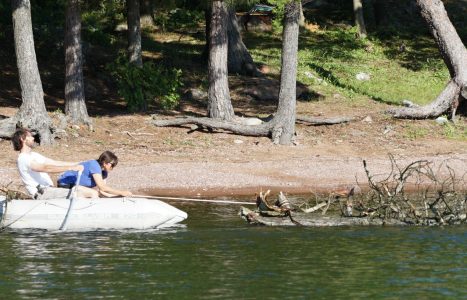We warily watched the storm front race along a course parallel to our own. Barely five miles off our starboard, the storm clouds presented a whirling wall of dark malevolence punctuated by flashes of lightning. Rumbling thunder was felt as much as heard. Trailing eastward as far as we could see, the sinister cloud bank segued from pitch black to seamless shades of grey. We could smell the rain and hoped that Magic Carpet was already safely nestled in Croker Island’s hurricane hole when the storm caught up with them. Jerry and Clare had left Little Current in their Ontario 32 several hours ahead of us. They typically take a route to that part of the North Channel that gets them north quickly before angling west. We charted a more southerly course to Croker Island and were halfway there as we watched the leading edge of the storm engulf the island.
We also hoped the storm would move on by the time we had to steer more directly north toward our friends’ presumed location. Just in case, we checked our charts for alternative places to hole up. If the storm stalled or swerved into our track, we didn’t want to be caught out in open water. The channels ahead were rife with submerged rocks and treacherous shoals.
We had remained in Little Current to see our guests, Mark and Jeanne, off to Minneapolis in their SUV. We also took the time to provision the boat, refuel and do some laundry at Spider Bay Marina. By the time we fired up the diesel and headed west it was midafternoon. Despite the westbound weather system off starboard, we had little wind to catch. So we motored. With 16 nautical miles to go, we expected to arrive at Croker by 5:30.
Fortunately for us the storm raced ahead and to the north. We encountered a few scattered spits as we cruised between Clapperton and Amedroz islands, but no big winds or driving rain. As we rounded Secretary Island to enter the bay defined by Croker, the sky was still grey but nonthreatening. We spotted Magic Carpet tucked into the northeast corner of the bay among several other sailing and power boats. We dropped anchor nearby and shut our engine down at 5:15—exactly three hours after leaving Spider Bay in Little Current.
Over refreshments aboard Magic Carpet a little later, Jerry and Clare recounted how midafternoon turned to midnight as they followed their northerly track. They described the next hour as a wild, wet carny ride. Lashed by high, swirling winds, they were pummeled with driving rain. Lightning and thunder flashed and crashed all around them. It was one of the wildest storms they remembered encountering in over 30 years of sailing the North Channel.
Julie and I were glad we missed that excitement.
A Quest for Firewood
The next day we stayed aboard Gaviidae relaxing, cleaning and doing routine boat chores. In the afternoon we noticed two of the crew from a neighboring sailboat clamber up the steep rocky slope to the right of a landing and picnic area ashore—200 feet from our location. They began breaking branches off a downed pine tree. Once they somewhat streamlined the deadfall, the scavengers proceeded to roll the newly denuded never-to-be-green-again tree some 30 feet down the slope over and around boulders to the water’s edge.  Their dinghy was tied to shore nearby. The pair—a young man and a young woman—tied a line to the bottom end of the tree, got into the dinghy and pulled the snag on into the water. They then towed their ungainly bounty to the picnic area; the woman held onto the rope while her partner rowed the dinghy. Another of the crew was already at the landing where he had been gathering and piling dry grass and deadfall tree branches in a high pyramid for a bonfire. The entire scene was straight out of a Three Stooges episode.
Their dinghy was tied to shore nearby. The pair—a young man and a young woman—tied a line to the bottom end of the tree, got into the dinghy and pulled the snag on into the water. They then towed their ungainly bounty to the picnic area; the woman held onto the rope while her partner rowed the dinghy. Another of the crew was already at the landing where he had been gathering and piling dry grass and deadfall tree branches in a high pyramid for a bonfire. The entire scene was straight out of a Three Stooges episode.
A short time later we were hailed by one of the wood-gathering sailors and invited to their bonfire later that night. During our conversation I offered to let them use the collapsible wood saw we have on board. It’s one of several items from my camping/canoeing/horse-and-backpacking days that have proven useful for wilderness sailing on the Great Lakes. He gratefully accepted the saw and returned it later, again encouraging us to join them for the fire. Julie and I discussed going ashore but opted to watch the conflagration from our cockpit. It was a wise decision as the fire didn’t start until after 10pm and looked a bit out of control.
Nature’s Fireworks
We were also entertained that night by celestial fireworks. Earth was passing near the Swift-Tuttle comet orbit that yields the famous Perseid meteor showers every year in August. The light show that night was best seen from the water as Croker’s high ridge blocked the view of the northeastern sky where the constellation of Perseus can be found. We had a couple hours of clear dark sky to enjoy shooting stars streaking overhead before the waning gibbous moon made its appearance and lit the sky up. Sparks from the bonfire seemed to shoot into the sky and merge with the stars. After more than a week of company aboard—even with good friends—we were content to have the evening, the shooting sparks and stars and the big moon to ourselves.
August 11 – 13, 2017 Croker Island-North Channel Ontario 46°04.898’N 82°12.583’W 1396 Nautical Miles
##

Lovely memories to get through the chill of a cold winter week. Thank you.